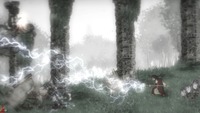|
|

|
PLATFORM
|
PS4
|
BATTLE SYSTEM
|

|
INTERACTION
|

|
ORIGINALITY
|

|
STORY
|

|
MUSIC & SOUND
|

|
VISUALS
|

|
CHALLENGE
|
Hard
|
COMPLETION TIME
|
20-40 Hours
|
|
OVERALL

|
+ Darkly fascinating boss designs
+ Even failing is valuable
+ Wide array of stat options to tinker with
- Plot is largely absent and unremarkable
- High risk at frustration at cheap deaths
|
Click here for scoring definitions
|
|
|
It's one thing for Ska Studios to model its latest game, Salt and Sanctuary, heavily after the Dark Souls series. It's another to then release it on March 15, 2016, mere days before Dark Souls III's Japanese release and upcoming worldwide debut. Having hacked and slashed my way through it, I can safely say that it's much more than just a passable clone designed to cash in on FromSoftware's hype. Its well-timed release constitutes a pretty ballsy move on Ska's part to, at worst, steal some of the upcoming juggernaut's thunder. At best, it will give players a whole new collection of punishing boss fights and murderous gameplay to sink their time into. Either way you hack or slash it, it's a win-win situation.
The core gameplay mechanics will be instantly familiar to anyone with a working knowledge of FromSoftware's catalog. Players navigate across and beneath a vast island labyrinth, exploring gloomy forests and dank caverns, climbing to the tops of ruined towers, then descending into the bowels of sparsely-lit dungeons. Slaying creatures nets the player salt, which is used for purchasing levels. Just as in Souls, all salt is lost upon death, though players get one chance to reclaim it. Dying again before regaining it will cause it to be gone for good, however.
Players choose from several character classes, like the familiar knight, mage, or paladin, or the more esoteric pauper or chef classes, depending on their preferred combat style — from a distance or up-close and personal. A wealth of cosmetic options is available to personalize the avatar. Armed combat is fast-paced yet simplistic enough to be mapped to primarily one button, though there are lots of ways to go deeper and tinker with stats. Exchanging certain items with blacksmiths will allow players to level up their weapons and armor, and alchemists can transmute them into more powerful, wholly new forms with added stat bonuses.
Combat effectiveness is not just about weapons and armor. The UI allows for two distinct weapon loadouts to be equipped, and players can switch between them on the fly with the simple press of a button. Additionally, up to four distinct rings can be equipped, and each loadout can be accessorized with a different fetish. A powerful parry-and-riposte move can turn the tide of battle, though it's difficult to time right and isn't necessarily vital. The in-game armory grants access to many alternative weapon types as well, such as bows, guns, whips, and grenades.
 Magic is a viable alternative to getting too close to the baddies.
Magic is a viable alternative to getting too close to the baddies.
|
|
All enemies have patterns and weaknesses that must be sniffed out to stay alive. Even so, bosses may require additional preparation, like drastically changing up equipment or gaining a few levels before trying again. The challenge throughout the game stays fairly constant, with the exception of a stretch near the beginning, consisting of three or four bosses that can just be blown through in a row. However, even when showing its teeth, Salt and Sanctuary has that "I'll get it on the next try" quality that is the mark of a great game. Far from a waste of time, failure is actually a learning opportunity, and players continuously adapt and improve the more they fail.
Salt and Sanctuary's story takes a bit of a back seat, as it's never the primary focus. Players find themselves washed ashore a mysterious island after ruthless fighters boarded their ship, slaughtering everyone else on board. What starts as a search for a way off the island soon hits a few unexpected snags when the player encounters familiar structures from the farthest corners of the world, somehow wholly transported here and reassembled on the island. By the time the credits roll, players may have gained some answers to these and other questions, though sections of it are entirely missable as the story is delivered via dialog with NPCs, who themselves are scattered all over the island. When the narrative actually does move forward, it almost feels like a lucky accident.
A small handful of side quests do exist, which are triggered by running into three specific NPCs repeatedly over the course of the campaign, as they themselves travel across the island, tucked away in the farthest corners and highest ledges of the environments. Rather than performing any specific tasks, these quests consist solely of listening to the NPCs tell their tales. It's not an engaging gameplay concept, but it does serve to flesh out the game's lore a bit more.
A bigger draw is the actual exploration of the twenty distinct environments that make up the island. Though early stages are more streamlined, the world becomes more interconnected as the player progresses through it. Locked doors and closed gates stop progress, though little by little they are opened after attaining the right key or pulling a certain lever. In true Souls fashion, shortcuts are everywhere and connect back to previously visited sections. A fast travel option is also available, though only through the use of stone idols which must first be found. It's easy to underestimate the scale of Salt and Sanctuary, but make no mistake: there is much to see and fight, and players may have as many as two or three regions available to explore at any given time.
Of course, a discussion of Salt and Sanctuary must address the elephant in the room: the stylistic change from the Souls series' full 3D environments to a 2D side-scroller. While the idea of losing an entire dimension might initially turn off some Souls die-hards, Ska Studios has drawn on its expertise from games like The Dishwasher and Charlie Murder to make it work. While the shift inevitably leads to platforming sections, the developers were careful not to make these overly prevalent. The only time they ever become a major source of frustration is in one area, late in the game, where players have to jump between platforms that constantly phase in and out of existence. On a positive note, new areas become accessible by backtracking to previously visited sections after acquiring abilities like the wall jump or inverted flip, adding to the sense that there's always something new to discover.
 The Queen of Smiles has lots of ways to cut players to shreds, and she won't even break a sweat doing it.
The Queen of Smiles has lots of ways to cut players to shreds, and she won't even break a sweat doing it.
|
|
What really makes the game work are this sense of discovery and the sweet taste of a hard-earned victory against a boss who made life a living hell for the longest time. The game doesn't short-change players here. Nineteen critical path bosses must be vanquished, and there are four optional ones to discover. It doesn't hurt that the actual boss designs are — and this may sound odd for such a dark game — delightful. Each new encounter comes with a sense of dreadful wonder; as grim as the battles can be, there's a giddy anticipation each time one enters a new boss area. From the Queen of Smiles' horrendous "grin" to the cloud of muscled arms and chomping teeth that is That Stench Most Foul, Ska Games pours a lot of creative juices into its creature designs. Some bosses are towering behemoths not able to fit onto the screen, and some are teams of two or even three that have to be faced simultaneously.
To level up, players take their amassed salt to the game's other namesake, a sanctuary. The landscape is dotted with these rooms of respite, as well as smaller shrines that act as checkpoints. Be warned, though: stopping at any one of these to save and restock on healing potions automatically respawns all slain enemies and resets traps that have been triggered. Before a sanctuary can be used, it must be dedicated to the player's deity. There are numerous religions to choose from, and it is possible to forsake one god and pledge to another, though there are repercussions for this sort of frivolous faith-hopping. NPCs that have taken up residence in a shrine — blacksmiths, clerics, merchants, etc — will only lend their services to a player if he still holds to their faith, and will immediately attack should players choose to desecrate their altar altogether.
Luckily, leveling up can be done at any sanctuary, regardless of creed. Each level comes with a basic stat bump, as well as a Black Pearl that unlocks a node within the massive Tree of Skill. Rather than a linear path through set upgrades, Salt and Sanctuary's skill tree radiates out from a center starting point, with wildly branching paths that interconnect with each other, offering a high degree of customization to the player. The skill tree is massive, and unlocked abilities carry over to the New Game Plus mode that is available after completing the game.
The game is both dark and strangely blanched of color, with that unique "Ska Studios look." Those familiar with its previous work will immediately recognize the understated richness of the art, which almost looks like pencil sketches and coal rubbings, using pops of color to great effect. There is an uncompromising quality about the art style, almost as if it's daring the player to like it. The music, when there is any, works well: coarse guitar riffs, with a few hauntingly melodic tracks for sanctuary visits and boss fights. But much of the game is simply accompanied by the sound of mailed feet and swords clashing against one another, which can be a little jarring.
Ultimately, Salt and Sanctuary goes beyond simply aping the trademark difficulty of the Souls games. It has a lot to offer those looking to pass the time until the next Dark Souls release, as well as those willing to dive even deeper down the rabbit-hole. Upgrading gear, transmuting weapons, and the vast skill tree should be pleasing features for stat hounds. Of course, all players "worth their salt" will expect a high degree of challenge, which Salt and Sanctuary gleefully dishes out in spades. But it's doing so with aplomb that pushes it over the top and gives it the high-water mark of a great game, and a remarkable fusion of several distinct styles. Neither fans of Metroidvania games nor of the Souls series will want to miss this one.
Review Archives
|









